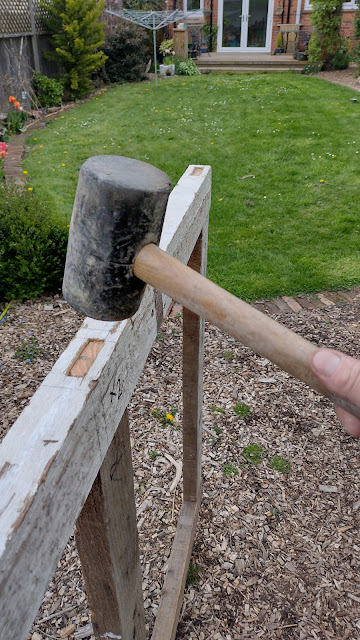Our nice new gate...
Why a new gate?
Having started the long-overdue process of clearing the far side of the house, there was a need to close off the passageway, that was created by clearing our years of accumulated junk and overgrown trees and ivy.
Now, you can buy gates from DIY shops etc, but...
a. they cost £150 or more
b. they are pretty flimsy
So, I built one instead. Almost all the wood was reclaimed from skips etc.
Build
In this shot, you can see the outer stiles, top and bottom rails are clean, planed timber and the central lock rail is from a plasterboard pallet rail (marked by the word "Gypsum")
I did buy some wood - this was a couple of 4" by 2" planed lengths for the two stiles (the longest vertical pieces at each side of the gate).
I could have used reclaimed wood, but I hadn't been able to quickly scavange two decent straight pieces, that were true enough. I also just I wanted to crack on with it.
The bought timber cost about £15 for the pair. There was enough extra length to cut the top and bottom rails from them after cutting the initial stiles.
Before joining up the outer frame, I also added some vertical mullions to connect the rails for added strength. Mullions are also uprights, like the stiles, but they are not full length. They are bracing connectors between the horizontal rails. These were cut from the same pallets as the centre rail. The mullions were pallet facing-planks.
All the joints between stiles, railes mullions were tasty mortice and tenon joints. These are are super strong.
I appear not to have any decent closeups of the mortices and tenons being cut, though - oops!
This zoom-in will have to do.
The mortices (holes) were cut by initially drilling out most of the waste wood with a spade bit, then trimming the rest with chisels. I , did final tidying with a file for a good fit.
Here is a joint after gluing and cramping
Here are the chisels used. The large paring chisel is a tasty 50cm wide. The smaller chisel I bought in a flea market in Tokyo. But my favourite tool here is the carver's mallet. I made this from hawthorn wood that I discovered by the roadside a few years ago. A surprisingly lovely wood.
After the frame was glued and had set, I added beading inside the openings between the frame parts. The beading would allow me to set in panels, to fill in the gate.
The beading after setting
The panels were offcuts from plywood crates used to transport fireplaces. They are fairly rough 5 ply sheets. by gluing and screwing these in, the overall frame is even further strengthened by the cross-bracing they provide.
The final gate. The panelling was added to both sides of the gate. With its jointed frame and double-thickness panelled bracing, the gate is really solid and heavy.
























































